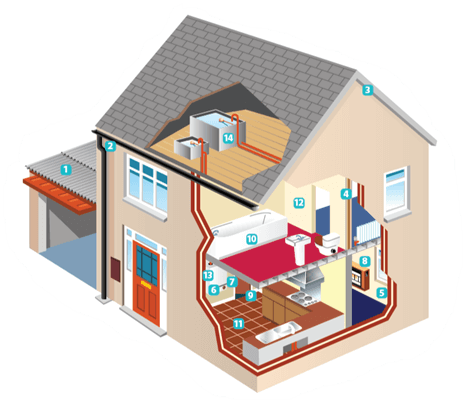Asbestos
This page is designed to provide you with information about the risks associated with asbestos containing materials and the actions you should take to minimise the risk of potential exposure to asbestos in your home.
What is asbestos?
Asbestos is a naturally occurring mineral made up of many small fibres. It is mined from rock and milled into fibres from which a wide range of materials can be produced. It has been used commercially for about 150 years because it is strong, flexible and stable. The three types of asbestos that have been used in the UK are:
- Crocidolite (blue asbestos)
- Amosite (brown asbestos)
- Chrysotile (white asbestos)
Asbestos materials pose little risk to health unless they are disturbed in some way that allows the fibres to be released into the atmosphere. This will occur if the asbestos containing material is drilled, sanded, cut or broken up, but could also occur if it is generally in a poor or damaged condition.
Where can asbestos be found in the home?
Asbestos fibres are strong and resistant to heat and chemicals. This led to their widespread use in a wide range of building materials and products, particularly during the 1960s and 1970s. Asbestos was often used as fireproofing but also as a general building material.
There are asbestos containing materials in about 5.5 million buildings in the UK. Because asbestos has been so widely used, there is a very low level of asbestos fibres in the air everywhere. Yet the risk to the general public from asbestos in the home is low.
The illustration below shows some common areas where asbestos containing materials may be found in and around the home, however the list is not all-inclusive:

Exterior:
- Garage roofing and shed sheets, tiles or roofing felt
- Gutters and down pipes
- Soffit and fascia boards
Interior:
- Partition walls
- Panels beneath windows
- Cupboards and around domestic boilers
- Panels behind electrical equipment
- Panels behind fires or heaters
- Panels on or inside fire doors
- Bath panels
- Floor tiles
- Textured wall and ceiling coatings (artex)
- Gaskets and rope seals inside gas and solid fuel appliances
- Cold water storage tanks
What are the health risks with asbestos?
Although asbestos is a hazardous material, it can only pose a risk to health if the asbestos fibres become airborne and are then breathed in. When asbestos containing materials are damaged or deteriorate with age, they can release tiny fibres into the air. If you breathe these fibres deep into the lungs, they may become lodged and cause damage to the lungs leading to lung disease in future.
What action should be taken if there is asbestos?
The Health and Safety Executive recommend that asbestos containing materials that are in good condition and that are not at risk of being damaged are best left where they are, undisturbed.
Works undertaken in tenant’s homes by us include a risk assessment to check whether it is likely the work will disturb any asbestos containing materials. Where asbestos may be disturbed or is found to be damaged, it will be managed safely either by sealing or enclosing the material (known as encapsulation), through removal by either our staff who have received appropriate training on how to remove asbestos safely or in some cases, removal by specialist contractors.
DIY work - How to reduce the risk
Before undertaking any alterations to your home you must first obtain permission from us.
This is because DIY work can result in brief but high levels of exposure so if you suspect materials might contain asbestos
then do not:
- Carry out DIY work on asbestos containing materials
- Disturb any asbestos containing material
- Drill into any asbestos containing material
- Scrape or sand any asbestos containing material
- Attempt to remove any asbestos containing material
If you are worried about a particular building product in your home, you should bring it to the attention of Ashfield District Council by contacting our Repairs Call Handling Centre on
- telephone: 01623 457999
- email info@ashfield.gov.uk
Asbestos Register
We maintain a domestic Asbestos Register which we update as appropriate. If you are planning home improvements and think you have asbestos in your home, always ask our permission in the first instance so we can check our records and advise if any asbestos is present or arrange for an asbestos survey to be carried out.
We insist that when asbestos needs to be removed, sealed or repaired, this must be carried out by appropriately trained Council employees, or for higher risk works, by specialist contractors who hold a licence issued by the government. Licensed contractors follow strict regulations and procedures to ensure asbestos materials are safely worked on and handled.
Remember:
Asbestos is only a risk to health if it is in poor condition, broken, or if you are actually working on it causing fibres to be released into the air.
Further information
The following organisations can provide further information and advice on asbestos:
How to get in touch
- email: info@ashfield.gov.uk
- telephone: 01623 450000 or 01623 457999
